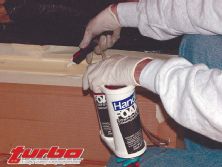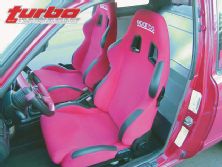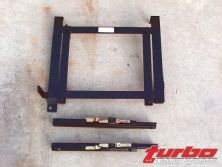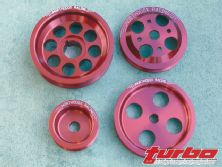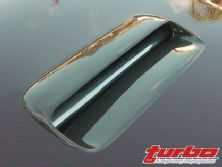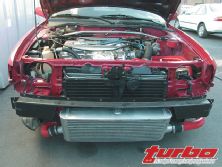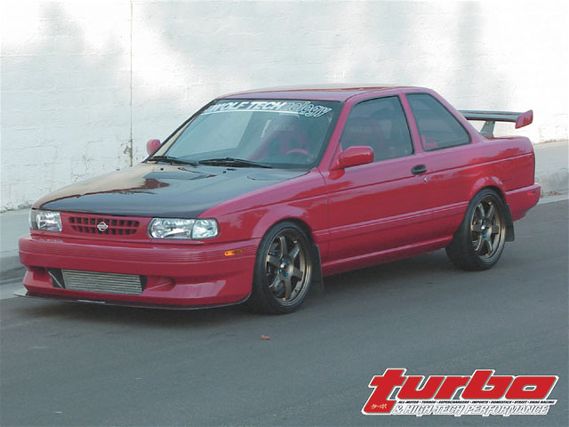 | 1991 Nissan Sentra SE-R - Transforming A Classic SE-R From Vermin House To Power House
| 1991 Nissan Sentra SE-R - Transforming A Classic SE-R From Vermin House To Power House
I've always had a soft spot in my heart for the early classic ('91 to '94) Nissan Sentra SE-R. I loved this car's sleeper image and the torquey power produced by its nearly indestructible SR20DE engine. I had even road raced an SE-R in SCCA SSB and IMSA Firehawk, where I learned to love its easy-to-drive, stable and nimble handling.
Years ago, I was impressed with the efforts of Evan Griffey and his pioneering project Turbo SE-R in Turbo Magazine. I read those pages many times and dreamed, determined to one day build my very own turbo SE-R.
One day a friend who owns a local performance shop,called me, complaining that a customer had brought in an SE-R for work and later disappeared, never to be heard from again. The guy stiffed him. After several months without contact, he stripped the trick parts he had installed in the car and pushed it outside his shop in disgust, where it became a mouse and squirrel condo.
Half-jokingly I told him to give it to me before he resorted to towing it away. Suddenly with a lien sale and a bunch of paperwork, I was the proud owner of a 1991 SE-R.
The car was a mess. It needed an engine, the suspension and brakes were totally shot and the interior was completely ruined by an invasion of vermin. With this in mind, I rolled up my sleeves and went to work.
The car's interior was stripped and mostly discarded. The carpet was sprayed with disinfectant and hosed several times, and the seats, with their stuffing of mouse excrement, were thrown in the trash. Tons of poorly done wiring from a badly installed aftermarket stereo, alarm and some sort of unidentifiable aftermarket ignition system were stripped. Fur-lined mouse nests and at least 20 pounds of nuts filled all corners of the car.
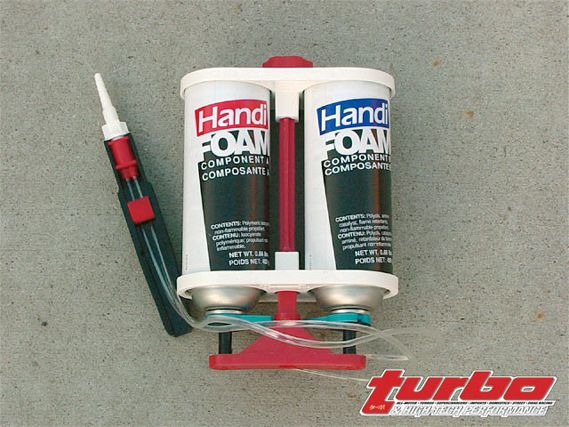 | With the interior stripped, I took advantage of its condition to inject Foamseal Catalyzed Urethane Foam into the car's unibody. Foamseal foam is pretty amazing stuff. It can increase the stiffness of large cross-section chassis members by up to 40 percent.
| With the interior stripped, I took advantage of its condition to inject Foamseal Catalyzed Urethane Foam into the car's unibody. Foamseal foam is pretty amazing stuff. It can increase the stiffness of large cross-section chassis members by up to 40 percent.
While the carpet was out, some sort of smelly unidentifiable liquid had seeped into the car's tar-like sound deadening. After freezing with dry ice (an old racers' trick) we easily scraped that away, disgusted; we would rather have a loud car than a smelly one. This trick got rid of about 25 pounds as well. The once-bare interior was completely washed and sprayed with disinfectant. Hantavirus is bad. The vermin also chewed up much of the Sentra's wiring harness; many hours were spent tracking and fixing shorts.
With the interior stripped, I took advantage of its condition to inject Foamseal Catalyzed Urethane Foam into the car's unibody. Foamseal foam is pretty amazing stuff. It can increase the stiffness of large, cross-section chassis members by up to 40 percent. We have used it in several project street and racecars to stiffen unibodies with good results.
The Foamseal foam was injected into every major frame section through the factory access holes. Foam injection is a popular mod in Japan to stiffen the chassis, but few are aware of it here in the States. Do not try to duplicate this with cheap hardware store spray foam, which won't harden inside the framerails of a car and has no structural properties.
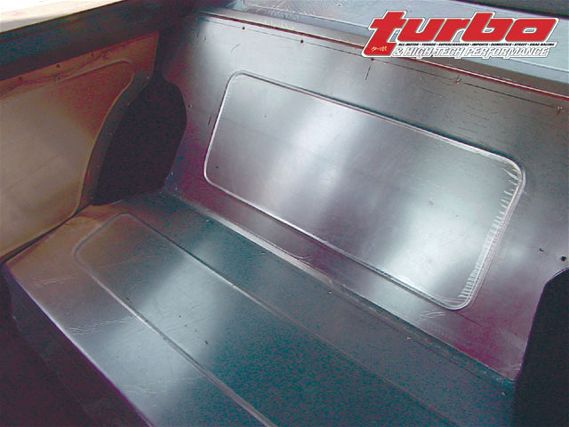 | 1991 Nissan Sentra SE-R - Transforming A Classic SE-R From Vermin House To Power House
| 1991 Nissan Sentra SE-R - Transforming A Classic SE-R From Vermin House To Power House
Since much of the Nissan's interior had been thrown away, Phil Lee of Pro Audio Motorsports and Mario Lozano of Toe Speed Fabrication teamed to build some aluminum panels for the rear of the car. These replaced the factory rear seat, rear deck and quarter panel trim pieces.
The cleaned carpet and Sparco Torino Seats were installed, the latter by using Wedge Engineering adaptors. The Wedge adaptors made installing the Sparcos an easy bolt-on, a usually difficult trick as the SE-R's seatbelts attach to the seats. A Sparco Color 2 replaced the worn, sun-rotted stock steering wheel, Sparco Grip Pedals were selected to make heel-and-toe shifting easy and a Sparco Classic shift knob replaced the nasty, sticky rotten shift knob.
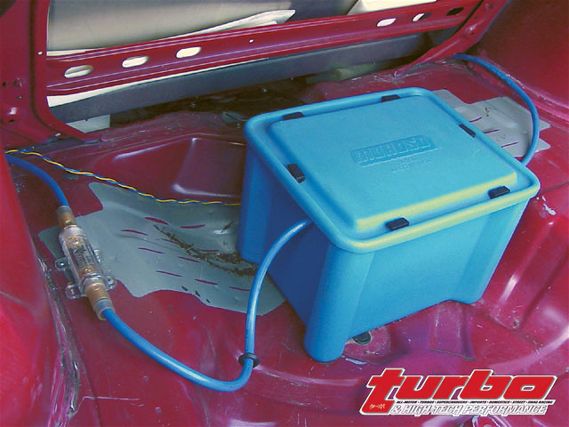 | Relocating the battery to the trunk with a Moroso relocation kit optimized weight distribution. On small FWD cars, this makes an obvious difference in handling, and moving the battery's 30 lbs. from the front of the car to the back improves weight distribution by more than 1 percent.
| Relocating the battery to the trunk with a Moroso relocation kit optimized weight distribution. On small FWD cars, this makes an obvious difference in handling, and moving the battery's 30 lbs. from the front of the car to the back improves weight distribution by more than 1 percent.
Since the Nissan is going to be an all-around car with handling capabilities to match its straight-line speed, we helped our weight distribution by relocating the battery to the trunk with a Moroso relocation kit. On small FWD cars, this makes a noticable difference in handling; moving the battery's 30 pounds from the front of the car to the back improves weight distribution.
An Optima red top gel cell battery was used for safety reasons. The Optima won't spew acid in a crash and can be placed in any direction. It also does not vent acidic, corrosive gas as it charges.
With the interior sanitized and smelling much better, our car was no longer a health hazard. A cherry, used low-mileage JDM engine from Soken, a local engine importer, was bought for the bargain price of $375 so Project SE-R could get rolling under its own power again.
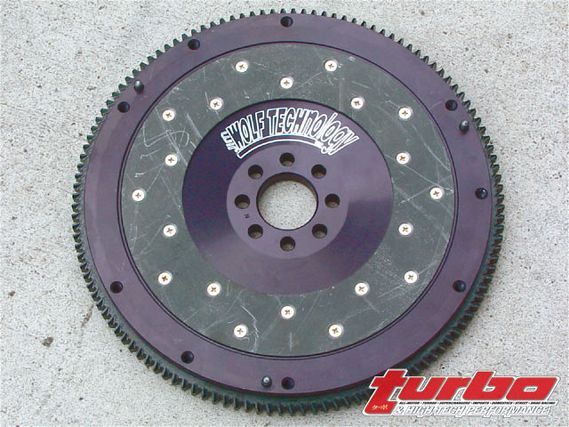 | A heavy-duty Stage 3 clutch and a lightweight 11 lb. aluminum flywheel from Jim Wolf Technology (JWT) in anticipation of our future turbo kit. The JWT clutch features a hard-holding, metallic puck friction material on the pressure plate side with a smooth-engaging organic side on the flywheel side of the disc. The JWT pressure plate has 40-percent more clamping force than stock to go with this composite disc.
| A heavy-duty Stage 3 clutch and a lightweight 11 lb. aluminum flywheel from Jim Wolf Technology (JWT) in anticipation of our future turbo kit. The JWT clutch features a hard-holding, metallic puck friction material on the pressure plate side with a smooth-engaging organic side on the flywheel side of the disc. The JWT pressure plate has 40-percent more clamping force than stock to go with this composite disc.
Before bolting our engine to our tranny, we installed a heavy-duty Stage 3 clutch and a lightweight 11-pound aluminum flywheel from Jim Wolf Technology (JWT) in anticipation of our future turbo kit. The JWT clutch features a hard-holding metallic puck friction material on the pressure plate side with a smooth-engaging organic side on the flywheel side of the disc. The JWT pressure plate has 40 percent more clamping force than stock to go with this composite disc.
An Unorthodox Racing's CNC-machined, billet aluminum underdrive pulley set was also added. This pulley set has been dyno proven to add 6 wheel hp to the SR20. As a side advantage, the UD pulleys also help with a classic SR20 weakness. The SR20's water pump cavitates at about 6500 rpm. This makes track-driven SR20s prone to overheating. The UD pulley reduces the water pump drive speed and makes the engine a lot less likely to overheat when the car is roadraced.
We also took this opportunity to polish our valve cover and re-plumb our engine's vacuum lines with high-temperature Hose Techniques Silicone hose.
To make the faded and battered body look somewhat presentable, we enlisted the help of Brian Kono of After Hours Automotive. Brian color-sanded and buffed the faded paint that had been scorched from sitting outside for several years. Although the paint was still not really 100 percent, it was good enough to look decent from 10 feet away.
Brian replaced our dented and smashed rear deck with a new, genuine Nissan deck. In doing so, he noted that our car had been hit hard from behind and poorly repaired. The rear frame was bent and the previous decklid had not closed right. Brian straightened the back part of the chassis on a frame machine.
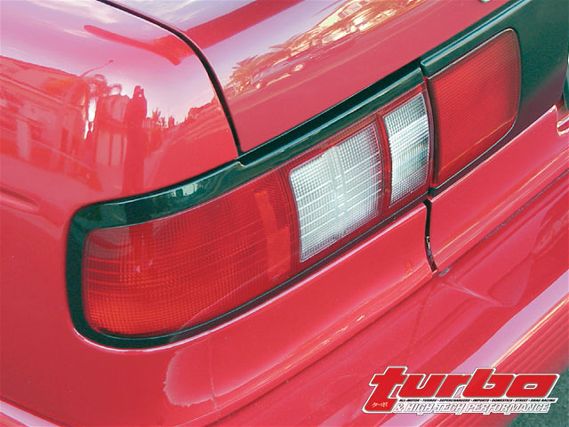 | New rear taillights, a back panel with clear turn signals and no amber sections from a Mexican Tsuru supplied by Mossy Performance freshen the look of the rear of the car.
| New rear taillights, a back panel with clear turn signals and no amber sections from a Mexican Tsuru supplied by Mossy Performance freshen the look of the rear of the car.
New rear taillights and a back panel with clear turn signals and no amber sections from a Mexican Tsuru supplied by Mossy Performance were used to give the rear of the car a fresh look.
In Mexico, the B13 was produced until the year 2000 and sold under the name Tsuru instead of Sentra. This long production run of the B13 for the Mexican and Canadian market is why Nissan freaks often refer to the B13 as the Classic. Mossy Performance is the high-performance division of Mossy Nissan, a large chain of Nissan dealerships in the San Diego area.
Since the B13 has a horrible 0.42 drag coefficient and a lift-producing boxy shape, we decided functional aerodynamic aids were needed. Fiber Images supplied a carbon-fiber rear wing for the car. The wing is made of Carbon Kevlar and has a red Kevlar weave to complement our car's red paint. The wing also has a true aerodynamic profile so it is capable of actually providing badly needed downforce.
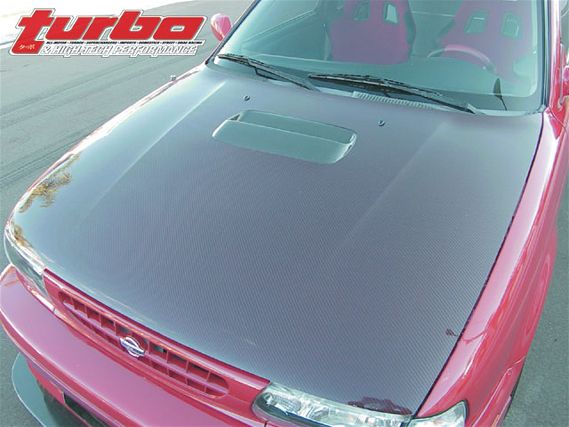 | A 12-pound Fiber Images lightweight carbon hood was added to the mix, saving quite a bit from the stock hood's 38 pounds. Brian grafted in a carbon hood vent from Carbon Trix to give our soon-to-be-installed turbo a place to vent hot air.
| A 12-pound Fiber Images lightweight carbon hood was added to the mix, saving quite a bit from the stock hood's 38 pounds. Brian grafted in a carbon hood vent from Carbon Trix to give our soon-to-be-installed turbo a place to vent hot air.
Fiber Images also supplied a lightweight carbon hood that weighs a mere 12 lbs, saving quite a bit from the stock hood's 38 pounds. Brian grafted in a carbon hood vent from Carbon Trix to give hot air produced by our soon-to-be-installed turbo a place to vent. When trying to install the hood, it was apparent that something was seriously wrong. The hood would not fit, and under closer inspection, it was apparent the car was in a serious front-end collision and incompetently repaired. The core support was caved in and was simply and crudely bashed out and covered with Bondo to hide the damage. The front frame rails were warped and not pulled out. Brian cut off the damaged core support and front fender aprons. He then pulled the frame rails straight and tig-welded new, genuine Nissan parts in place.
We were getting quite committed; the costs of making our project safe and solid were far exceeding the value of the hulk we had gotten for free.
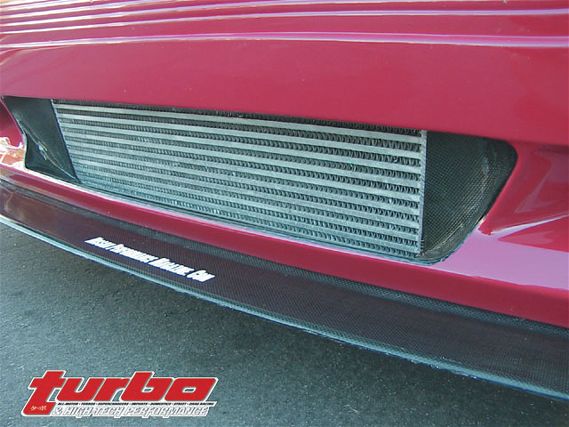 | A Xenon urethane airdam was bonded with structural urethane adhesive and blended into a new stock bumper skin; the job came out so clean, it looked like one piece. An enlarged front grille opening on the Xenon piece and a carbon air baffle ensure 100 percent of the air taken in the front of the car was forced through the core of our optional oversized F-Max front-mount intercooler.
| A Xenon urethane airdam was bonded with structural urethane adhesive and blended into a new stock bumper skin; the job came out so clean, it looked like one piece. An enlarged front grille opening on the Xenon piece and a carbon air baffle ensure 100 percent of the air taken in the front of the car was forced through the core of our optional oversized F-Max front-mount intercooler.
A Xenon urethane airdam was bonded with structural urethane adhesive and blended into a new stock bumper skin, the job coming out so clean it looked like one piece. Brian also enlarged the front grille opening of the Xenon piece and built a carbon air baffle to ensure that 100 percent of all air being taken through the front of the car was forced through the core of our oversized F-Max front-mount intercooler. Correct ducting increases an intercooler's effectiveness and none of the surface area of our IC is blocked or shrouded.
To further improve engine cooling, a Nissan Motorsports radiator was bolted in. Brian actually mounted the radiator further up in the car to allow room for our anticipated turbo system, notching and reinforcing the core support for additional clearance. There is still room for the air conditioning condenser as we do not want to give up creature comforts.
Courtesy Nissan, another performance-friendly Nissan dealer, supplied Project SE-R with another striking mod. The SE-R was updated with a set of clear-lensed projector-beam headlights, clear corners and a front grille from a late-model Mexican Tsuru.
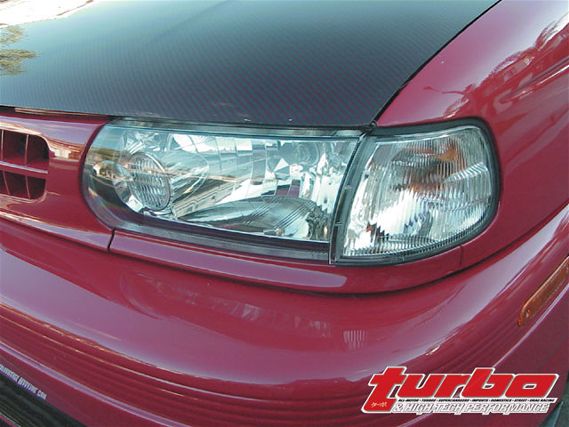 | A set of clear-lensed projector-beam headlights, clear corners and a front grille from a late-model Mexican Tsuru update the SE-R's front end.
| A set of clear-lensed projector-beam headlights, clear corners and a front grille from a late-model Mexican Tsuru update the SE-R's front end.
Unlike cheesy aftermarket clear light products on the market, these are genuine Nissan parts that fit perfectly and function well. These lights throw quite a better beam than the hazed and cloudy old stock lights did. In addition, they really give the 10-year-old B13 a fresh, contemporary look. Brian painted the grille and lower light surround to match our car and installed the parts.
Finally, to complete the Sentra's fresh new look, a set of bronze-anodized Volk TE37's in 17x7.5 with a 40mm offset were installed. The TE37 is a high-tech, super-light forged wheel favored by touring car racers around the world. The wheels weighed a feathery 14 pounds each, impressive for a 17-inch wheel. Our racing experience also tells us the TE37 is an exceptionally strong wheel as I have personally banged many a set against FIA curbs and potholes on the track with no damage.
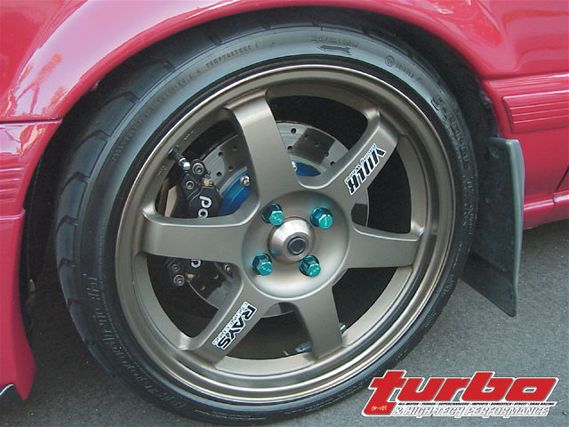 | To complete the Sentra's fresh new look, a set of bronze anodized Volk TE37's in 17x7.5 with a 40mm offset were installed. The TE37 is a high tech, super-light forged wheel favored by touring car racers around the world. The wheels weigh a feathery 14 pounds. each, impressive for a 17-inch wheel.
| To complete the Sentra's fresh new look, a set of bronze anodized Volk TE37's in 17x7.5 with a 40mm offset were installed. The TE37 is a high tech, super-light forged wheel favored by touring car racers around the world. The wheels weigh a feathery 14 pounds. each, impressive for a 17-inch wheel.
Impressed with the tire's results in our G-Force challenge earlier in the year, we selected a set of BFGoodrich G-Force KD tires. We stuffed some 205/40-17 KDs into our wheelwells. We did have to slightly roll our rear fenders to prevent a tiny bit of rubbing but it was no big deal; a few minutes and a few taps of a soft mallet did the trick.
Like the legendary Phoenix, our Junkyard Dog is coming around, arising from the ashes of its pathetic, formerly wrecked self, being reborn into something much better. The car is looking presentable once again and sporting some functional aerodynamic aids. It can move under its own power and the insides no longer smell like a cattle ranch on a hot summer day.
In our next edition, we will cover the installation and dynoing of our F-Max turbo system and explore the limits of a bone-stock SR20DE with crappy California 91-octane gas.

